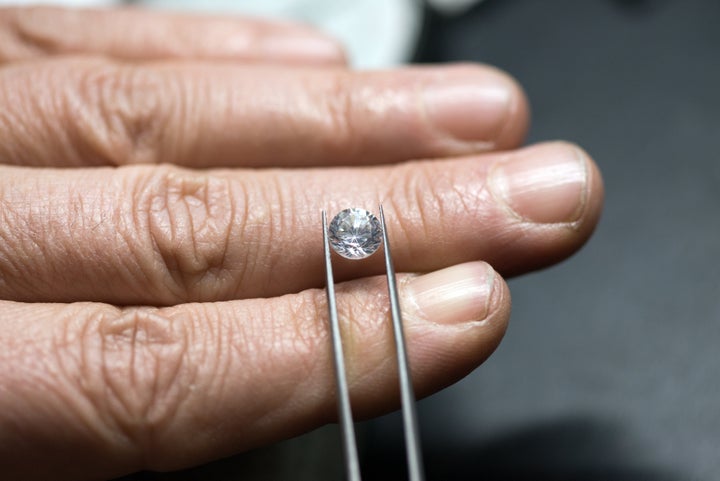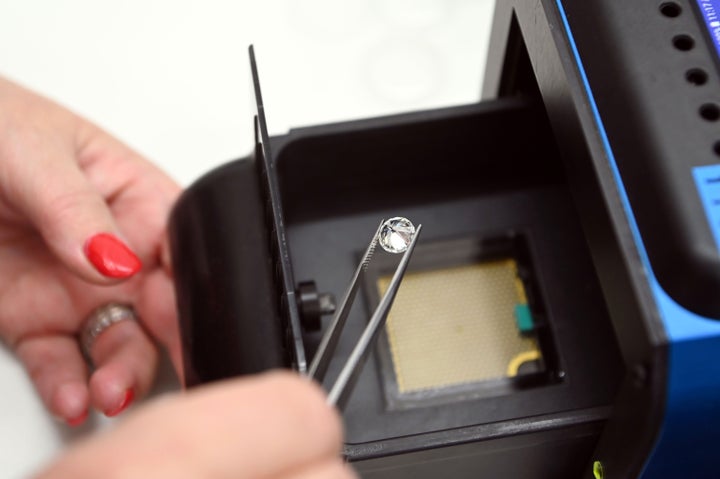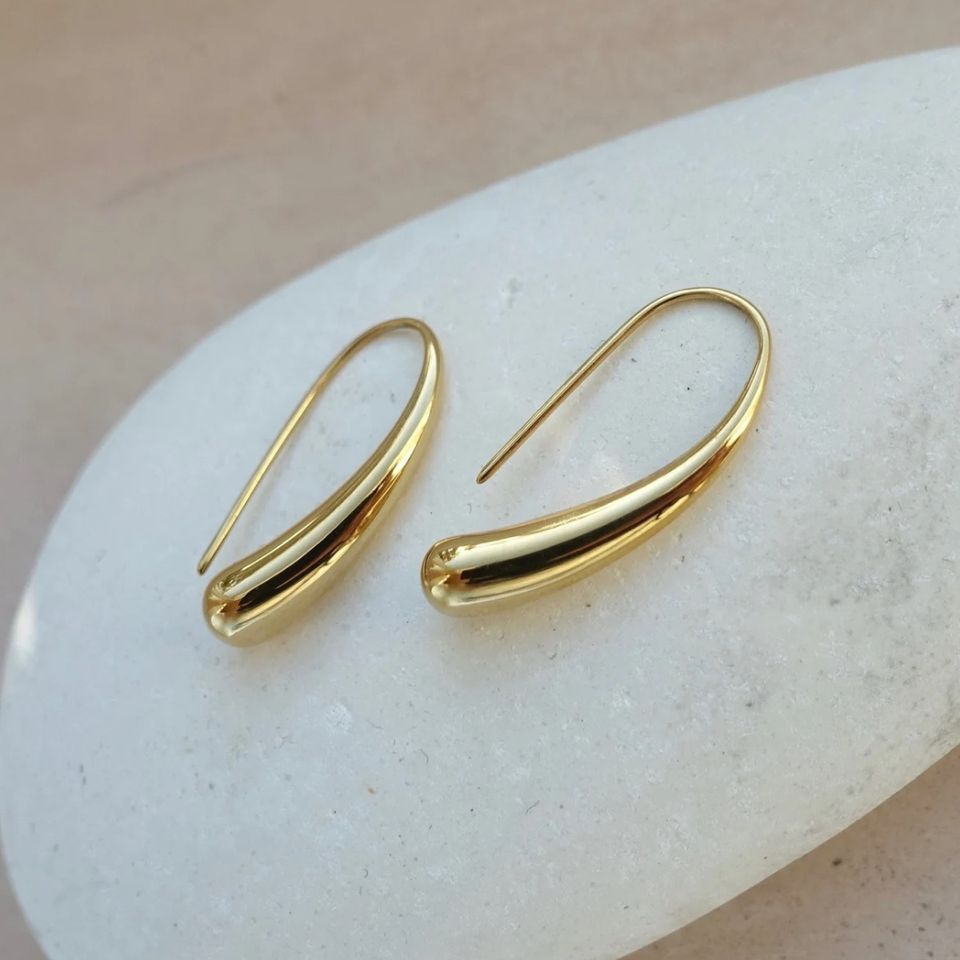
If you’ve bought a piece of fine jewelry containing a diamond in recent years, you’ve likely encountered a more affordable option in a lab-grown diamond — especially if you were in the market for an engagement ring.
While you may shell out around $23,000 for a 2-carat halo ring of natural diamonds, the lab-grown version of the same ring might cost $6,000 — a staggering difference for two options that are visually, chemically and physically the same.
Laboratory-grown, or synthetic, diamonds are more popular than ever as consumers are drawn to their affordability compared to mined, or natural, diamonds. Plus, sustainability and ethics are now top of mind for many diamond shoppers, even more so since the 2006 film “Blood Diamond” shed light on many of the inhumane practices in traditional diamond mining.
But when you ask the experts, the differences between mined and lab-grown diamonds aren’t so cut and dry — especially where ethics and sustainability are concerned. We talked to four industry experts to break it down.
Synthetic diamonds are created in a laboratory, and they sometimes begin as a tiny piece of a natural diamond.
As the name implies, lab-grown diamonds are created in a laboratory, rather than harvested from nature. “Technically speaking, there are two ways of producing lab-grown diamonds,” explained Avi Levy, the president of North America for the International Gemological Institute. “The first is the high-pressure, high-temperature (HPHT) method, where heavy mechanical presses and intense heat are combined to replicate the conditions under which natural diamonds formed. The second is chemical vapor deposition (CVD), a process that superheats gas into plasma, releasing carbon atoms to ‘build’ a diamond crystal at the atomic level.”
Both methods actually start with a tiny piece of a mined diamond. “A sliver of a natural diamond ‘seed’ [is] placed in a chamber,” said Anna Bario, co-founder of Bario Neal, which sells both lab-grown and natural diamonds. “The lab then adds carbon and heat, mimicking the way that diamonds form naturally in the Earth. The seed then grows and grows into a high-quality diamond.”
And while “both of these methods grow real diamonds,” said Levy, “one process (CVD) assembles the diamond in vertical layers and the other (HPHT) uses a metal catalyst to dissolve component carbon. These different approaches may produce microscopic inclusions (internal characteristics) which differ from those seen in natural diamonds, but not always. Once polished, both HPHT and CVD produce gemstones that look identical to natural diamonds.”
To the naked eye, there is no difference between a mined and lab-grown diamond.
According to the experts, there is no way for the average person to differentiate a natural from a lab-grown diamond. “There are no differences to the naked eye,” Levy said. “Lab-grown diamonds are real diamonds, scientifically, chemically, physically and optically. You can only separate natural and lab-grown diamonds with sophisticated testing.”
They’re also identical when it comes to hardness, both scoring a 10 (the highest value) on the Mohs scale, which is used to define hardness of materials.
There are two ways that trained experts can spot a synthetic diamond. “There are small but significant differences in inclusions and growth structure that allow a trained gemologist to distinguish between natural and lab-created diamonds. These differences may only be identified under extreme magnification,” said George Leifheit, vice president of global strategic sourcing for Signet, the parent company of Kay, which sells both lab-grown and natural diamonds.
Another method is by a tiny inscription, which is required in a lab-grown diamond. “Per the U.S. Federal Trade Commission, all lab-created diamonds are required to carry the label ‘lab-created’ or ‘lab-grown’ so the consumer can have confidence in the diamond they are buying,” added Leifheit.
Lab-grown diamonds are much cheaper than natural diamonds, even of the same quality.
Since visually and chemically, the two vareities are the same, the biggest discernible difference is the price point — and it’s a substantial one. When picking a lab-grown diamond over a natural one, “you can frequently double the carat weight for the same budget,” Levy said.
Diamonds are graded based on their clarity, cut, carat and color (known as the four Cs). If a natural diamond and a lab-grown diamond rank equally in all four categories, the lab-created version will be significantly cheaper — about 20-30% cheaper on average, estimated Leifheit, adding, “The price difference will increase as the carat size goes up.”

Simply put, with lab-created diamonds, you get more for your money. “They offer large finger coverage for a more affordable price,” Bario said.
The reason for the financial variation is based on the rarity and the history of a mined diamond. “Materials from the Earth, like mined diamonds and gemstones, are cosmic-level pieces of planetary history,” Bario explained. “They formed into existence over centuries, long before we held them, and those ancient elements can’t be replicated in a lab.”
“One day, the Earth will run out of economic diamond mines, but synthetic diamond manufacturing offers an inexhaustible supply,” said Jessica Cadzow-Collins, a qualified gemologist, former heritage director of Garrard (which made many of the U.K.’s crown jewels over 140 years) and founder of Jessica May Jewels. “Natural diamonds are being depleted, and in time … access to natural diamonds will almost certainly run out. The cost of natural diamonds has risen slowly but steadily over the last 30 years and continues to do so.”
There’s also a major disparity when it comes to resale value. “Synthetic diamonds are cheap and plentiful and are made by a widely replicated process compared to natural diamonds, so there is absolutely no resale value,” Cadzow-Collins added. “Natural diamonds retain their value indefinitely.”
Both lab-grown and mined diamonds can be more and less sustainable, depending on a company’s process.
Though many people assume that purchasing a lab-grown diamond will be a more sustainable and ethical choice than purchasing a mined diamond, that’s not always the case. Part of that is due to the recent positive changes in the diamond mining industry.
“When it comes to natural diamonds, no other industry has done more to oppose ‘conflict minerals’ (including gold, tin, tungsten, coltan, etc.) than the modern diamond industry,” Levy said. “The world’s largest miners have put programs in place partnering with Indigenous people and communities where their diamonds are extracted. There are still geopolitical issues impacting supply in places … but since the end of the last century sweeping changes have taken place in the interest of environmental, social and governance (ESG) — the framework used to assess an organization’s business practices and performance on various sustainability and ethical issues.”
Moreover, “many consumers might also think that an advantage of cultivated diamonds is ‘zero impact’ on the environment, however, that claim is not possible for lab-grown or mined diamonds (or really any inorganic object that’s human-made),” Bario said. “Both require water and nonrenewable energies like oil, gas or coal to fuel them.”
In fact, depending on exactly how it’s done and who is doing the growing, diamond creation in a laboratory setting may not be sustainable at all due to “the vast amount of electricity that is required to power six weeks of unimaginable amount of heat and pressure required in the advanced technological processes that replicate the dense carbon crystal lattices of diamond,” Cadzow-Collins noted.
Still, there are ways to create a diamond more responsibly than others. “Some lab-grown diamond producers have emerged using hydro and solar power, and they can provide third-party scientific proof of sustainability from organizations such as SCS Global,” Levy said.
If sustainability is important to you when purchasing a lab-grown diamond, it’s imperative to research your retailer. “If you are choosing a lab diamond from a jeweler, it’s important to question where they are sourcing the lab diamonds. Are they produced in the USA? Are there any carbon offsets made during the manufacturing? Where are the diamonds faceted and polished?” Bario said.

Moissanite is another affordable alternative, but you can see the difference.
For people looking for affordable alternatives to mined diamonds, moissanite presents another good option — although this colorless stone can be discerned from a diamond with the naked eye. A 2-carat moissanite stone might be around $3,500, Bario noted, where a lab-grown diamond of the same carat weight might be around $6,000.
“Similar to cultivated [lab-grown] diamonds, [moissanite] is more accessibly priced than mined natural diamonds. Moissanite is nearly as hard as diamonds, so stones can be worn every day and in a variety of sizes. The only visible difference might be the sparkle. If you’re really paying attention, a large moissanite will cast a rainbow shine, while a natural diamond has a truer white sparkle,” Bario said.
Although moissanite is most commonly created in a lab due to its rarity in the Earth, “it’s much easier to manufacture than diamond,” Cadzow-Collins noted. Other alternatives, such as white topaz and cubic zirconia, “are softer with rounded facet edges and are generally less sparkly,” she added.
Still, despite alternatives like lab-grown diamonds being more prevalent than ever, they still only account for 2% of the total diamond jewelry market, estimated Cadzow-Collins, though synthetic diamonds are expected to “grow to about 5% over the next decade.”
And in the engagement ring industry, Leifheit noted, “natural diamonds are still the leading gemstone.”
CORRECTION: A prior subheadline of this story incorrectly referred to lab-grown diamonds as “simulated.”
